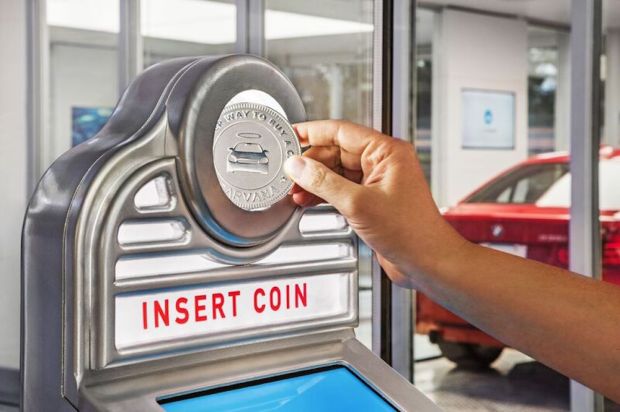How Car Vending Machines Evolved From 1880s England

Years before consumers could buy a Ford from a vending machine, Percival Everitt had a rather novel idea for the early 1880s: He invented the first coin-operated vending machine.
Making their debut in London, the machines made appearances at post offices and train stations. The machine’s offerings were simple – envelopes, notepaper and postcards. The machine’s form factor wasn’t exactly small, though. The cast-iron machines were as tall as the average adult. But they had some advanced features, at least at the time.
When all of the products in the machine were sold out, Everitt’s machine was designed to close the coin slot. As a result, consumers wouldn’t pay for a product that they wouldn’t be able to receive.
Everitt also had another rather smart idea: He put the machine in high-traffic areas. Locations near railroad trips were particularly preferable as railroad workers could help monitor his machines.
A few years later, the concept would make the journey across the Atlantic to the United States. The Thomas Adams Gum Company installed vending machines in 1888 on subway platforms in New York City to sell Tutti-Fruiti gum. And, to draw consumers to the vending machines, the company introduced an eye-catching feature – animated figures.
The Automated Restaurant
Vending machines would soon get more advanced and sell more than candy or postcards. In 1902, Horn and Hardart opened an automated coin-operated cafeteria in Philadelphia. Soon, the company would open one in Manhattan, too.
Horn and Hardart’s “Automat Lunch Room” in Times Square, for example, contained a large coin-operating vending machine with rows of windowed compartments that contained food, such as macaroni and cheese or pie. Customers would browse the selection and, when they were ready to make a purchase, put a nickel into a coin slot that would open the compartment.
Still, the set up wasn’t completely automated. Kitchen staff still had to restock the compartments, after all.
But the automats were a hit. At one point, there were more than 36 of them in New York City and they served 800,000 people a day.
The automated kitchenette wouldn’t last forever, however. As Horn and Hardart had to raise prices to keep up with inflation, coin-operated machines no longer made sense.
Fast food chains then came on to the scene, and even Horn & Hardart wanted to get in on the action. The company actually purchased some franchises. Then it was only a matter of time: The last Horn & Hardart Automat closed in 1991.
The Automated Car Dealership
Vending machines have since evolved to sell more high-ticket items, say, caviar or cars. In March, for example Carvana opened one of its car vending machines in Tampa, Florida. That machine is eight stories tall and holds up to 32 vehicles, the company said in an announcement at the time.
Their giant vehicle vending machines, which have been helping Carvana make headlines, are, in part, a bit of an advertising ploy. Installing one of the highly-visible structures in a new city is a quick way to get the word out and establish the brand.
“It’s a great marketing presence,” Ryan Keeton, Carvana co-founder and chief brand officer, explained in a recent PYMNTS interview. “It’s a very oversized, glowing building made of glass, that’s a car vending machine. That can generate interest through local media, as well as just for people who are driving by on the road and [see it].”
The machine also shapes the customer experience by providing the convenience of a pick-up option and making the car acquisition process memorable.
A customer who has made a purchase online arrives at the lot, receives a three-inch branded coin from a staff member, pops it into the machine, and sees their car slowly lowered and released to them. While a QR-code might do the trick just as well as a coin, Keeton says he sticks by the metal disc for its tactility and the visceral, evocative quality of traditional vending machines.
“[We wanted to give customers] a memorable and impactful experience so people would want to go out and tell their friends and family about buying a used car,” Keeton said. “Let’s make car-buying fun again.”
Customers overseas can buy cars from a vending machine, too. Alibaba Group, for example, is expecting to install several of them in China. The idea may appeal to those who don’t want to deal with pesky salespeople or just those who like to use new technology to make purchases.
Jessica Wolfe, a principal at A.T. Kearney, told The Wall Street Journal, “A car vending machine is the ultimate word in frictionless commerce — you don’t have to deal with salespeople trying to talk you into things you don’t want, and you don’t have to haggle over price. You can think for yourself, do the research, and make the purchase when you’re ready on your phone. That’s exactly how millennials like to transact.”
Will the car vending machine go the way of the Automat, or will it be a mainstay in retail like the gumball machine? Only time will tell.
